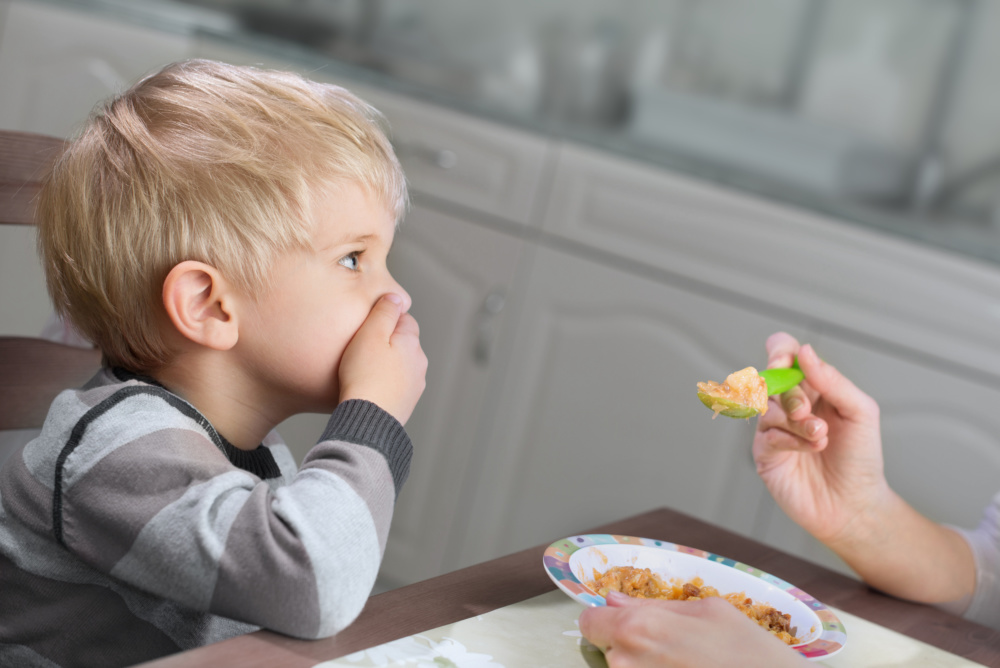A Parent’s Guide to Picky Eating
By Cristine D. Saks, MS, RD | CommuniCare
On a dinner outing with my 8-year-old nephew, the waiter asked if he would like a kid’s menu, and without batting an eye, he responded “I don’t need a kid’s menu. I’ll have the salmon.” As a dietitian who works with parents and small children, I know that so many parents would love to hear their children say these exact same words. Here are a few tips to help prevent your child from becoming a picky eater, or if your child is already a picky eater, to help them eat a greater variety of healthy foods.

Mother’s Diet
Prevention starts before your baby is even born. During pregnancy, the baby can taste what their mother is eating through amniotic fluid. To let the baby experience different flavors, pregnant mothers should eat a variety of healthy foods. Once the baby is born, if the mother is breastfeeding, the baby can continue to taste what she eats through her breast milk. This further exposes and allows the baby to become familiar with different flavors. The American Academy of Pediatrics (AAP) recommends exclusively breastfeeding or offering maternal milk for approximately six months. Once complementary foods are introduced, the AAP recommends continuing to breastfeed for at least one year. A 2011 study by Shim et al found that following this recommendation decreased the likelihood of a child developing picky eating behaviors during their preschool years.
Time and Method of Solid Food Introduction
Shim et al also found that the timing of solid food introduction also played a role in the development of picky eaters. Avoid starting your baby on solid foods until around six months, unless otherwise indicated by your pediatrician. Before this time, they are not developmentally or nutritionally ready for solid foods. Once solid foods are introduced, give one new food at a time. If a child rejects a food, don’t give up. Children naturally reject the unknown as a way of protecting themselves from harm. It can take between 10 and 20 exposures to the same food for a child to finally accept it.
“Avoid starting your baby on solid foods until around six months, unless otherwise indicated by your pediatrician. Before this time, they are not developmentally or nutritionally ready for solid foods.”
Divide Up the Responsibility
Parents and children have different responsibilities in feeding. Parents are responsible for the food purchased and prepared, as well as how it is presented. You can change the texture of the food and the seasonings. However, minimize the amount of salt you use on food so that your child can learn to enjoy the flavors of foods without added salt. You can also give your child their food on colorful plates and utensils. Continue to be a good role model by eating a variety of healthy foods. I promise you, your child is watching. Lastly, keep the eating environment calm and without distractions, such as TV, music, I-pads, and cell phones. Stress and distractions can affect the amount of food your child eats and can cause your child to dislike foods associated with stress.
The child’s responsibilities, on the other hand, are to choose how much they eat and whether they eat at all. As difficult as it may be, do not force your child to continue eating if they have not finished their meal. Let them set the pace for eating and allow them to touch and smell the food before they taste it.
Other Tips
Once your child is old enough, let them help choose foods at the grocery store. They can also help prepare foods in the kitchen. There are many simple tasks that they can participate in, such as washing fruits and vegetables, tearing lettuce for salads, and mixing ingredients. When children are involved in the preparation of meals, they are more likely to eat the meal.
It takes time, but if you are consistent with offering a variety of healthy foods every day, you might be the next one bragging about your child ordering off the adult menu.
References:
American Academy of Pediatrics, www.aap.org
Dovey, T., Staples, P., Gibson, E., & Halford, J. (2008). Food neophobia and ‘picky/fussy’ eating in children: A review. Appetite, 50(2-3), 181-193.
Hayes, D. (n.d.). Coping With Picky Eating Phases. Retrieved from http://www.eatright.org/kids/article.aspx?id=6442459366
Hayes, D. (n.d.). Introducing Solid Foods. Retrieved from http://www.eatright.org/kids/article.aspx?id=6442459352#authorinfo
Hermann, M. (n.d.). Expanding Your Baby’s Flavor Horizons. Retrieved from http://www.eatright.org/kids/article.aspx?id=6442459331
Shim, J., Kim, J., & Mathai, R. (2011). Associations of Infant Feeding Practices and Picky Eating Behaviors of Preschool Children. Journal of the American Dietetic Association, 111(9), 1363-1368.
For more information on the mission of CommuniCare Health Centers, visit communicaresa.org.







Recent Comments